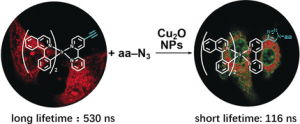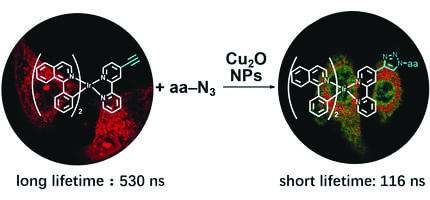–Cells are highly complex and organized entities which are composed of various biological events. Real-time live-cell imaging is important for understanding these physiological processes. However, many existing fluorescent probes are unsuitable for these purposes due to the background noise in the biological system and the interference of the unreacted probes under wash-free conditions. In addition, some probes are also unable to cross plasma membranes in their native environment, making probe delivery into live cells challenging.

To overcome these problems, a team led by Prof Juan Qiao and Prof. Xinrong Zhang from the Department of Chemistry at Tsinghua University has developed a novel near-IR bioorthogonal probe based on an Iridium-alkyne complex. With a terminal alkyne group, this probe is applicable to the click reaction of copper(I)-catalyzed azide–alkyne cycloaddition (CuAAC) . A remarkable shortened decay lifetime (414 ns) of the probe was observed upon triazole formation. As illustrated in the color of photoluminescence lifetime imaging (PLIM), this lifetime change could provide an effective way to distinguish the reacted iridium-alkyne from the unreacted probes, and thus enabling for real-time imaging of a synthesized protein within single living cells.
This study represents a successful approach for dynamic live-cell imaging, in which the background interference is eliminated and washing steps are not necessary. Moreover, the probe also offers benefits of excellent cell penetration, deep red to near-IR emission covering 600 to 800 nm, long stokes shift and resistant to photobleaching. Based on the unique properties of the probe, it is anticipated to have applications for imaging more biological processes within living cells in the near future.

















